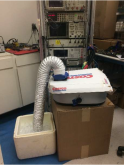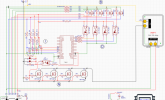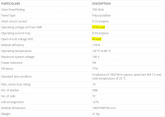Ahh, got caught up with a few things

.

M1-4 have their drain and source reversed because the negative side of the cells are on top on the schematic (see, that's why we put lowest potentials at the bottom; all schematic software use this orientation by default and components follow the same orientation).

Absolutely, there's surely some "rush-up" work that I despise. Thanks for the fine eye!
You forgot a resistor for the divider of the first cell so P1 on A7 (you also have a P1 on the cells side, that's 2 different nets, you can't have the same name for both) is directly connected to ground.
P1 is the same connection originating from first positive electrode on the battery going all the way to Balance Mosfet M4.
Since resource is the same - may be keeping it singleton would help reference them uniquely.
You can't have only one gate series resistor (R15) as else you create a voltage divider with R17/19/20/22. You need one per mosfet between the pull-down resistor and the gate (not between the pull-down resistor and the opto).
Well this could then be an inherent issue with mosfets in parallel configuration in general, as preceding mosfets could always interfere with voltage available to the last in series components. Have made some changes but still can't see through how best could this be done?
The Vgs on M1 is marginal as its Vgsth is 2.5 V max and the opto will have a 0.6-0.7 Vce so if the cell 4 is under 3.1-3.2 V you may not turn on M1 fully. I'd recommend to use a mosfet optocoupler instead of a BJT one so you don't have the PN junction 0.6 V drop.
M1(s) are STP90NF03L with Vgs of +/-20V driven from +12v supply from the battery itself. Vgs of +12V stemming from common ground should be high enough to activate Mosfet channel fully I believe. Do you still see it with doubt?
I'm curious what Vds breakdown voltage derating do you feel is a safe margin? It's been a while but I believe we've (military standard) always used 20V above max voltage. In other words, if max voltage is 50V, then fet should be rated for 70V (or greater).
Thats what I had in mind, with Voc of 45V anything below 70V isn't a buffer enough. May be a margin of 30% is good to restrain momentary spikes/flashes. Earlier had put a BIG 10,000 uF cap on the input supply from PVs to dampen such irregulations, but it got removed in later revisions.
What do you think - would it be good to have it?
What combined Rds_on resistance do you want to achieve for your switch?
Single digit milli Ohm scale should be fine. Anything above that isn't really meant to be used for heavy current conduction as it heats up the mosfet exponentially with linear increase in current - thus limiting the load capacity.
I believe it's already been mentioned, do you require 2 12V zeners in parallel with the 47uF cap? Gate drive current comes from the cap.
Edit:
Solar output is listed as 45V. What is that? Voc or Vmp?
Zeners in parallel are meant for redundancy.
Since they would be working much above their breakdown voltage (12v) may be putting a few in parallel could help save from unwanted surprises in field. As
@BiduleOhm said - most of the design isn't contingency proof but having them wouldn't hurt either.
I am concerned about long term reliability of these zeners - probably would have to put a buck converter circuitry in place at a later stage - for now - its the zeners at duty.
45V is Voc for 24V PV panels, Vmp should be around 40V once they are fully connected to the system.
" From whats available - would have to put at least 10 mosfets in parallel if not more to get 30Amp continuous. "
That's just not correct.
You're using IRF1407: 75V, 7.8 mOhm, 130A
Here's a P-channel:
IXTH120P065T: 65V, 10 mOhm, 120A
https://www.mouser.com/Semiconducto...=1z0xv21&Keyword=20A+p-channel+mosfet&FS=True
Virtually the same specs. Just use 4 of them for a high-side switch.
Right - as already shared by
@BiduleOhm, I'm working with small online stores with limited options in their inventory.
But thanks for the recommendation, if ever needed could check these ones

.
BTW I didn't say anything before but this website has a lot of red flags and might sell counterfeit parts. I would never buy components outside of the reputable vendors (Mouser, Farnell, Digikey, ...), especially power mosfets who are more counterfeited than other components.
Absolutely would agree to that, no contentions whatsoever

.
In the past Mosfets from some of the walk-in stores turned out to be counterfeit.
With current lockdown situation and limited mobility I'm trying multiple online local stores for components.
Some turned out to be good others no so and this one still remains to be checked.
Delivery is expected next week so would get to know their inventory.
International reputable ones are surely worth putting money on for bigger projects.
For small ones with counted component quantities their excessive shipping costs are prohibitive.
Lets see, if not would work through them as last resort.








